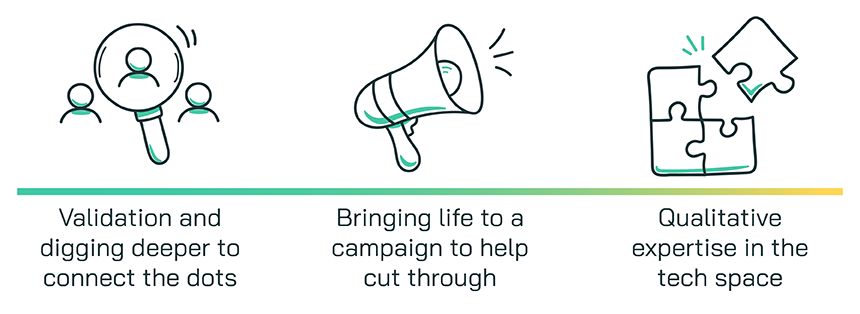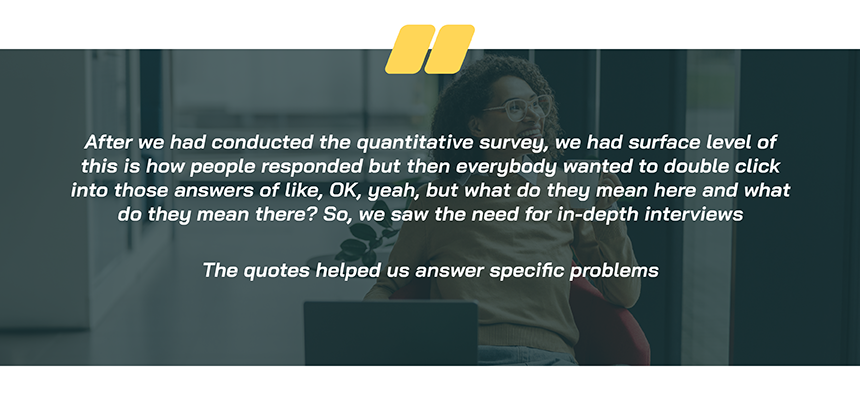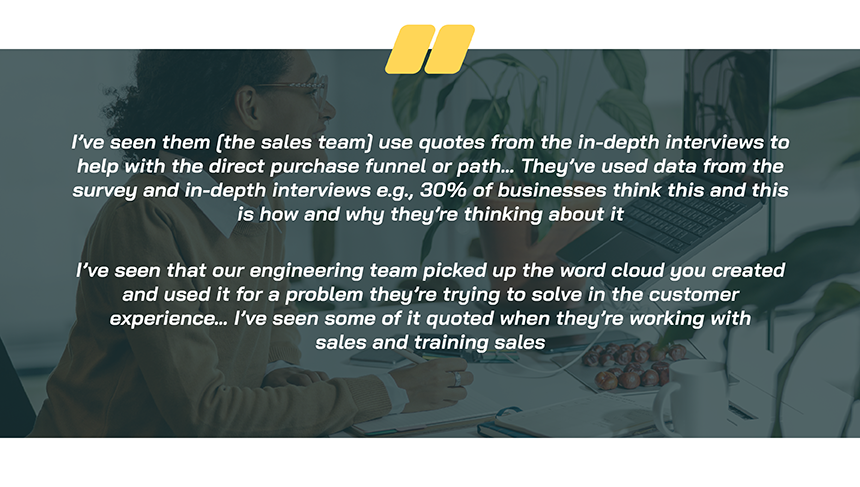Discover how combining qualitative with quantitative research helped one of our clients unlock even more value from their research.
We’ve spent more than 20 years dedicated to providing B2B market research in the technology sector and pride ourselves in being experts in both quantitative and qualitative methodologies. In fact, we’ve conducted many research projects that have a dual methodology – utilising qualitative in-depth interviews and quantitative surveys.
Despite what you might think, the two methodologies do not need to be seen in isolation – they work well together. Thus, we recommend using a combined approach for every research project.
We conduct in-depth interviews before or after a quantitative survey for two main reasons:
At the start: to help with idea creation/formulation for a quantitative survey
At the end: to dig into the quantitative findings in more detail, connecting the dots to find out the ‘why’ behind the ‘what’ and to help your research cut through in a crowded market
Three proven benefits of conducting in-depth interviews
We recently spoke to one of our clients – a senior marketer at a leading provider of IT consulting services across many technology verticals including Cloud, AI and cybersecurity – who conducted research using the second approach. Their main objective was to find out how businesses approach cybersecurity, including their path to purchase. The project consisted of a quantitative survey to over 1,000 decision makers, followed by 20 qualitative in-depth interviews. A prime example of combining qualitative and quantitative research methodologies.
Our discussion revealed three key reasons why conducting in-depth interviews on their behalf was beneficial:

Validation and digging deeper
Consequently, the quantitative survey had given them a robust view of opinions and attitudes when it comes to purchasing cybersecurity tools and solutions. Layering qualitative insights allowed them to validate the new questions and conclusions arising from the results. This provided extra meaning behind the findings, helping to answer the ‘why’ behind the ‘what’.
Here’s what they told us:

Bringing life to a campaign
Combining quantitative survey results and qualitative quotes enabled them to share insights internally, allowing teams to harness research for various uses. The real-life meaning behind the quotes showcased why it was great to do business with them, helping with campaigns and sales.
Here’s two examples they gave of how the results were used by two separate teams across the organisation:

VB as qualitative experts in the tech space
Close collaboration between ourselves and the client allowed us to ensure topics were explored with confidence and without bias. The client was able to utilise our expertise in the tech space. They appreciated our consultative and collaborative approach in delivering a successful research project.
We asked for their views on how the collaborative discussion guide process went and to give their thoughts on the insight discussion. These were the results:

It’s the ‘why’ behind the ‘what’, bringing research to life
Our team are highly skilled to guide you through the extensive insights that in-depth interviews can yield, really drawing out the ‘why’ behind the ‘what’ to illuminate the aspects of the results that truly matter most to your business. Think of us as your expedition guide, navigating the mountain of qualitative and quantitative research. While we highlight key points of interest along the way.
More of our clients are using qualitative methods like in-depth interviews to generate ideas, support campaigns, and achieve cut-through. To help get you started, discover five things you need to know about qualitative research and get in touch to discuss your what you’re looking to achieve.
For now, we’ll end with the words of our client:





